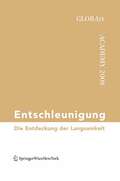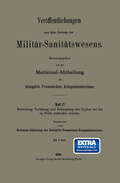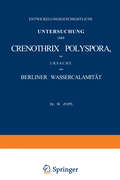- Table View
- List View
Entropy, Divergence, and Majorization in Classical and Quantum Thermodynamics (SpringerBriefs in Mathematical Physics #16)
by Takahiro SagawaRich information-theoretic structure in out-of-equilibrium thermodynamics exists in both the classical and quantum regimes, leading to the fruitful interplay among statistical physics, quantum information theory, and mathematical theories such as matrix analysis and asymptotic probability theory. The main purpose of this book is to clarify how information theory works behind thermodynamics and to shed modern light on it.The book focuses on both purely information-theoretic concepts and their physical implications. From the mathematical point of view, rigorous proofs of fundamental properties of entropies, divergences, and majorization are presented in a self-contained manner. From the physics perspective, modern formulations of thermodynamics are discussed, with a focus on stochastic thermodynamics and resource theory of thermodynamics. In particular, resource theory is a recently developed field as a branch of quantum information theory to quantify “useful resources” and has an intrinsic connection to various fundamental ideas of mathematics and information theory. This book serves as a concise introduction to important ingredients of the information-theoretic formulation of thermodynamics.
Entropy, Environment and Resources: An Essay in Physico-Economics
by Malte Faber Horst Niemes Gunter StephanEntropy, Environment and Resources: An Essay in Physico-Economics
by Malte Faber Horst Niemes Gunter StephanLong run aspects of environmental protection and of the use of resources areanalyzed within a planning model. To this end fundamental concepts of thermodynamics are explained in a simple manner. The relationships between entropy, energy necessary for the extraction of a resource and the concentration of the resource is employed to establish a connection between the economic systems and the environment.
Entropy, Large Deviations, and Statistical Mechanics (Classics in Mathematics)
by Richard S. EllisFrom the reviews: "... Each chapter of the book is followed by a notes section and by a problems section. There are over 100 problems, many of which have hints. The book may be recommended as a text, it provides a completly self-contained reading ..." --S. Pogosian in Zentralblatt für Mathematik
Entropy, Large Deviations, and Statistical Mechanics (Grundlehren der mathematischen Wissenschaften #271)
by Richard.S. EllisThis book has two main topics: large deviations and equilibrium statistical mechanics. I hope to convince the reader that these topics have many points of contact and that in being treated together, they enrich each other. Entropy, in its various guises, is their common core. The large deviation theory which is developed in this book focuses upon convergence properties of certain stochastic systems. An elementary example is the weak law of large numbers. For each positive e, P{ISn/nl 2: e} con verges to zero as n --+ 00, where Sn is the nth partial sum of indepen dent identically distributed random variables with zero mean. Large deviation theory shows that if the random variables are exponentially bounded, then the probabilities converge to zero exponentially fast as n --+ 00. The exponen tial decay allows one to prove the stronger property of almost sure conver gence (Sn/n --+ 0 a.s.). This example will be generalized extensively in the book. We will treat a large class of stochastic systems which involve both indepen dent and dependent random variables and which have the following features: probabilities converge to zero exponentially fast as the size of the system increases; the exponential decay leads to strong convergence properties of the system. The most fascinating aspect of the theory is that the exponential decay rates are computable in terms of entropy functions. This identification between entropy and decay rates of large deviation probabilities enhances the theory significantly.
Entropy Measures for Environmental Data: Description, Sampling and Inference for Data with Dependence Structures (Advances in Geographical and Environmental Sciences)
by Daniela Cocchi Linda AltieriThis book shows how to successfully adapt entropy measures to the complexity of environmental data. It also provides a unified framework that covers all main entropy and spatial entropy measures in the literature, with suggestions for their potential use in the analysis of environmental data such as biodiversity, land use and other phenomena occurring over space or time, or both. First, recent literature reviews about including spatial information in traditional entropy measures are presented, highlighting the advantages and disadvantages of past approaches and the difference in interpretation of their proposals. A consistent notation applicable to all approaches is introduced, and the authors’ own proposal is presented. Second, the use of entropy in spatial sampling is focused on, and a method with an outstanding performance when data show a negative or complex spatial correlation is proposed. The last part of the book covers estimating entropy and proposes a model-based approach that differs from all existing estimators, working with data presenting any departure from independence: presence of covariates, temporal or spatial correlation, or both. The theoretical parts are supported by environmental examples covering point data about biodiversity and lattice data about land use. Moreover, a practical section is provided for all parts of the book; in particular, the R package SpatEntropy covers not only the authors’ novel proposals, but also all the main entropy and spatial entropy indices available in the literature. R codes are supplemented to reproduce all the examples. This book is a valuable resource for students and researchers in applied sciences where the use of entropy measures is of interest and where data present dependence on space, time or covariates, such as geography, ecology, biology and landscape analysis.
Entropy Measures, Maximum Entropy Principle and Emerging Applications (Studies in Fuzziness and Soft Computing #119)
by KarmeshuThe last two decades have witnessed an enormous growth with regard to ap plications of information theoretic framework in areas of physical, biological, engineering and even social sciences. In particular, growth has been spectac ular in the field of information technology,soft computing,nonlinear systems and molecular biology. Claude Shannon in 1948 laid the foundation of the field of information theory in the context of communication theory. It is in deed remarkable that his framework is as relevant today as was when he 1 proposed it. Shannon died on Feb 24, 2001. Arun Netravali observes "As if assuming that inexpensive, high-speed processing would come to pass, Shan non figured out the upper limits on communication rates. First in telephone channels, then in optical communications, and now in wireless, Shannon has had the utmost value in defining the engineering limits we face". Shannon introduced the concept of entropy. The notable feature of the entropy frame work is that it enables quantification of uncertainty present in a system. In many realistic situations one is confronted only with partial or incomplete information in the form of moment, or bounds on these values etc. ; and it is then required to construct a probabilistic model from this partial information. In such situations, the principle of maximum entropy provides a rational ba sis for constructing a probabilistic model. It is thus necessary and important to keep track of advances in the applications of maximum entropy principle to ever expanding areas of knowledge.
The Entropy Principle: Thermodynamics for the Unsatisfied
by André ThessEntropy – the key concept of thermodynamics, clearly explained and carefully illustrated. This book presents an accurate definition of entropy in classical thermodynamics which does not “put the cart before the horse” and is suitable for basic and advanced university courses in thermodynamics. Entropy is the most important and at the same time the most difficult term of thermodynamics to understand. Many students are discontent with its classical definition since it is either based on “temperature” and “heat” which both cannot be accurately defined without entropy, or since it includes concepts such as “molecular disorder” which does not fit in a macroscopic theory. The physicists Elliott Lieb and Jakob Yngvason have recently developed a new formulation of thermodynamics which is free of these problems. The Lieb-Yngvason formulation of classical thermodynamics is based on the concept of adiabatic accessibility and culminates in the entropy principle. The entropy principle represents the accurate mathematical formulation of the second law of thermodynamics. Temperature becomes a derived quantity whereas ”heat” is no longer needed. This book makes the Lieb-Yngvason theory accessible to students. The presentation is supplemented by seven illustrative examples which explain the application of entropy and the entropy principle in practical problems in science and engineering.
Entry Inhibitors in HIV Therapy (Milestones in Drug Therapy)
by Jacqueline D. Reeves Cynthia A. DerdeynEntry Inhibitors in HIV Therapy details the current status of this relatively new and very dynamic class of inhibitors. A unique overview of obstacles and accomplishments is presented. The impact of viral sequence diversity on this class of inhibitors is discussed, and a connection between basic research and clinical studies is shown. The book presents a unique collection of contributors from basic research, pharmaceutical research, and the clinic.
Entscheidungen der Produktionsplanung mit einer Sammlung von BASIC-Programmen (Interdisciplinary Systems Research)
by WISSEBACHEntscheidungen in die weite Zukunft: Ungewissheiten bei der Entsorgung hochradioaktiver Abfälle (Energiepolitik und Klimaschutz. Energy Policy and Climate Protection)
by Anne Eckhardt Frank Becker Volker Mintzlaff Dirk Scheer Roman SeidlIn diesem Open-Access-Buch werden Wege aufgezeigt, mit verschiedenen Formen von Ungewissheiten und der Dynamik von Ungewissheiten bezüglich der Entsorgung radioaktiver Abfälle umzugehen. Die sichere Entsorgung radioaktiver Abfälle erfordert es, über Zeiträume von bis zu einer Million Jahre hinaus zu planen. Ein solches Vorhaben ist von erheblichen Ungewissheiten begleitet, die sich zudem auf dem Entsorgungsweg verändern. Dem Sammelband liegen inter- und transdisziplinäre Forschungsergebnisse zugrunde. Die Autor:innen sprechen in allgemein verständlicher Sprache eine breite Leserschaft an, die sich für die Entsorgung radioaktiver Abfälle oder grundlegender für den Umgang mit Vorhaben, die sehr langfristig angelegt sind, interessiert.
Entscheidungstheorie: Eine strukturtheoretische Darstellung (Interdisciplinary Systems Research)
by EGLEEntschleunigung: Die Entdeckung der Langsamkeit GLOBArt Academy 2008 (GLOBArt)
Die GLOBArt Academy 2008 befasste sich mit dem Thema „Entschleu- gung – die Entdeckung der Langsamkeit“. Das Kloster Pernegg – als Ort der Stille, der inneren Einkehr und der Kraft – erscheint ganz besonders geeignet, ein derartiges Thema im Kreis von Menschen aus vielfältigen - rufs- und Bildungsgruppen zu erarbeiten. In einer Zeit der exzessiven - tonung des Materiellen, rasanter (Fehl-)entwicklungen der Finanzmärkte und unübersehbar negativer Entwicklungen auf den Realmärkten und im Arbeitsmarkt verlieren wir alle leicht die Orientierung hin zu jenen W- ten und Lebensgrundlagen die das wirklich wesentliche Thema des Lebens ausmachen und die man nur mit innerer Gelassenheit zu entdecken v- mag. Werte, die also auch außerhalb des ?üchtigen Zeitbegriffes stehen: Tempus Fugit Gottes Mühlen mahlen langsam Die Zeit rettet die Wahrheit In zahlreichen Spruchweisheiten wird unser Generalthema in vielen K- turen in Gegenwart und Vergangenheit beschrieben. Jede Befassung mit dem Zeitbegriff ist eine Befassung mit der eigenen Endlichkeit und der uns unbegrei?ichen Unendlichkeit. Tempo und Langsamkeit, Beschleunigung und Entschleunigung sind T- men dieser irdischen begrenzten Zeitlichkeit. Es geht um die Auseinand- setzung mit tausenden auf uns einstürmenden Informationen und daraus permanent umgestürzten Prioritäten unseres täglichen Handelns und Ag- rens. Ein von Zwängen bestimmtes – in enge zeitliche Korsette gezwängtes passives Nebeneinander an Stelle eines aktiven Miteinanders. Konzentr- ren auf wirklich Wesentliches, das in der uns zur Verfügung stehenden Zeit positiv bewältigt und erlebt werden kann.
Entsorgungstechnik: Chemie und Verfahren
by Joachim Roll"Entsorgungstechnik - Chemie und Verfahren" provides an overview of current methods of waste treatment, exhaust air purification and cleaning up old industrial sites ... so that we are not stranded with our rubbish. The chemical fundamentals of the processes are described to provide better understanding of the reactions occurring while, at the same time, demonstrating the application of chemistry of the technology of disposal. Practical examples aid the assessment and choice of suitable disposal processes. The close relationship between chemistry and process makes this book of interest to both students of technical environmental protection and of chemistry. Furthermore, it offers those practically involved in the disposal industry the possibility of informing themselves concerning new developments in disposal technology.
Entstehung der mechanischen Festigkeit bei feuerfesten Erzeugnissen während des Trocknens (Forschungsberichte des Landes Nordrhein-Westfalen #1606)
by Kamillo KonopickyAn Tonstäben aus verschiedenen charakteristischen Rohstoffen wurden die Möglichkeiten untersucht, einen Elastizitäts-Modul in Abhängigkeit vom Feuch tigkeitsgehalt mit Hilfe einer dynamischen Methode zu bestimmen. Mit fort schreitender Trocknung wurde ein Ansteigen der Elastizität beobachtet. Für das anisotrope Material läßt sich auch im plastischen Zustand ein Äquivalent-Elastizi täts-Modul finden, der mittels einer statischen Meßmethode überprüft werden konnte. Ferner war hierdurch die Möglichkeit gegeben, den elastischen und pla stischen Verformungsanteil getrennt zu erfassen. Die Untersuchungen könnten als Modell für die Aussagen des E-Moduls feuer fester Erzeugnisse bei hohen Temperaturen dienen. 7 1. Einleitung An plastisch geformten Tonstäben sollte untersucht werden, bei welchem Feuch tigkeitsgehalt im Verlaufe des Trocknens der Elastizitäts-Modul bestimmt werden kann, bzw. wie er während des Trocknens ansteigt. Dies ist in Zusammenhang mit der Beurteilung der Trockenempfindlichkeit des betreffenden Tones interessant, da die Rißbildung nicht nur vom Schwindmaß, sondern auch von der Starrheit bzw. der Elastizität des trocknenden Körpers abhängt.
Entstehung und Entwicklung des Rechtsextremismus in der Bundesrepublik: Zur Tradition einer besonderen politischen Kultur. Band 1
by Hans-Gerd JaschkeEntstehung, Verhütung und Bekämpfung des Typhus bei den im Felde stehenden Armeen (Veröffentlichungen aus dem Gebiete des Militär-Sanitätswesens)
by Medizinal-Abtheilung des Königlich PreussischenEntwickelungsgeschichtliche Untersuchung über Crenothrix Polyspora, die Ursache der Berliner Wassercalamität
by W. ZopfEntwicklung auf dem Gebiet der Chemiefaser-Herstellung: Rohstoff und Veredlung in der Textilwirtschaft (Arbeitsgemeinschaft für Forschung des Landes Nordrhein-Westfalen #12)
by Hermann RathertEntwicklung, Bau und Bedeutung der Keimdrüsenzwischenzellen: Eine Kritik der Steinachschen „Pubertätsdrüsenlehre“
by H. StieveDieser Buchtitel ist Teil des Digitalisierungsprojekts Springer Book Archives mit Publikationen, die seit den Anfängen des Verlags von 1842 erschienen sind. Der Verlag stellt mit diesem Archiv Quellen für die historische wie auch die disziplingeschichtliche Forschung zur Verfügung, die jeweils im historischen Kontext betrachtet werden müssen. Dieser Titel erschien in der Zeit vor 1945 und wird daher in seiner zeittypischen politisch-ideologischen Ausrichtung vom Verlag nicht beworben.
























